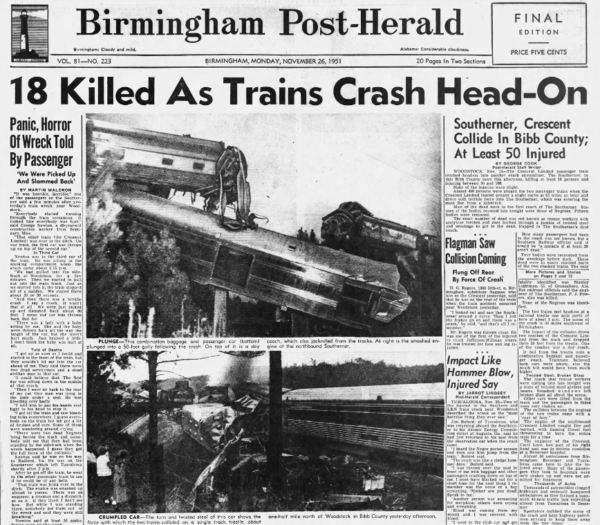Fine Weather Played a Contributing Role in the Thanksgiving Day 1951 Deadly Train Wreck in Woodstock
Beautiful weather ironically was a contributing factor in a deadly Alabama train wreck near Woodstock on Thanksgiving Day in 1951. On that fateful day, November 25th, the Southern Railway’s crack passenger train the southbound Crescent was detouring from its normal route from Atlanta to Montgomery on its way to New Orleans from New York. A damaged trestle on the L&N in South Alabama, the normal route for the Crescent, caused the train to be rerouted over Southern’s trackage through Birmingham and Tuscaloosa. The Crescent, officially designated Second 47, as it followed Train #47, the Southerner, departed Birmingham’s Terminal Station at 1:55 p.m., 20 minutes late.
Meanwhile, Southern Train #48, the northbound Southerner, had departed Tuscaloosa at 2:01 p.m., some six minutes late. #48 was instructed by the dispatcher to take the siding at Woodstock, on the Bibb/Tuscaloosa County line, which it did at 2:31 p.m. First Train #47 was stopped on the main line track just north of the south switch for the siding there. The lead engine carried a green flag indicating there was a second section of the train following it. As #48 rolled down the 1.62 mile long siding, the engineer looked at the signal about 1,300 feet ahead and called out “clear” and the fireman confirmed “clear”. But indeed, the signal was a red aspect, signaling a stop signal. This was of course, a critical error.
At about 800 feet, the red stop signal would have been clearly visible from the locomotive cab. But neither the engineer nor the fireman noticed it. As the train passed the signal, the Automatic Train Stop should have automatically applied the brakes. There is no indication that the engineer used the forestalling device, which would have permitted the train to continue moving. The report from the Interstate Commerce Commission indicated that the train must have been moving at more than 15 mph, the speed limit in the siding, which allowed the train to continue.
The switch at the north end of the siding was not aligned for #48 to return to the main line, a fact noticed by the fireman, who notified the engineer on #48. It is likely that the Automatic Train Stop equipment had applied brakes, and the engineer may have applied them also, but he was killed and could not be interviewed. The northbound train was not put into emergency stop and
#48 traveled through the switch and about 101 feet out onto the mainline.
The crew quickly realized they had made a terrible mistake and the fireman grabbed an orange rag and ran to protect the fouled mainline from any approaching train. The engineer from #48 ran backwards to try to notify the dispatcher on the phone some 92 feet to the south. He was killed by the derailing equipment.
Second 47, the renamed Crescent, was slowing from 80 to 65 mph as it approached the right hand curve just north of the Woodstock siding. The fireman from #48 had only run a short distance up the track when he saw the heavily loaded Second #47 barreling toward the imminent disaster. The Engineer on Second 47 saw the train fouling the track ahead and went into emergency stop, hitting his whistle twice in obedience to having seen the fireman’s frantic hand stop signal.
Second 47 slowed to about 45 mph when the collision occurred at 2:35 p.m. Two of the three crew members in the cab of the lead locomotive on Second 47 leapt from the train. One survived and one perished. The engineer on Second 47 actually survived.
The human carnage on Train 48 was terrible. The engine was pushed nearly 200 feet down the track. The baggage coach combine car right behind it was torn apart. Here is where most of the fatalities occurred. A total of 17 people died and 68 were injured.
The next day featured brilliant sunshine like the tragic day before, and investigators made a startling discovery. As they stood on the siding looking toward the signal, they realized that the bright sunshine reflecting off the lens made it impossible to see the stop aspect. The sun had washed out the signal.
Still, the Automatic Train Stop (ATS) system installed in the siding should have stopped the train as soon as it passed the restrictive signal. That was proven by a test train on December 2nd. It was then apparent that the engineer of Train #48 was traveling faster than the maximum allowed speed of 15 mph. The ICC would blame the wreck on
Folks around Birmingham talked about that Thanksgiving wreck at Woodstock for years.
Category: ALL POSTS, Met 101/Weather History
















